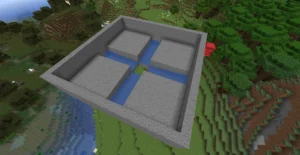Master the Art of Mob Farming in Minecraft: Ultimate Guide for Resources and XP
Mob farms are a game-changer in Minecraft, allowing you to automate resource collection and XP farming while saving time and effort. Whether you're looking to farm gunpowder, bones, or experience points, a well-designed mob farm can meet your needs. This comprehensive guide will walk you through How to make a mob farm in Minecraft, optimize it as an XP farm, and solve issues like How to stop spiders from spawning in a mob farm.
Highlights
- Learn to create efficient mob farms for resources and XP.
- Find out how to stop spiders from spawning in your mob farm.
- Optimize your farm for handling the strongest mobs in Minecraft.
Why Build a Mob Farm?
Building a mob farm in Minecraft is a game-changing strategy for players seeking efficiency and resource abundance. Mob farms automate the process of collecting valuable items like gunpowder, bones, string, and arrows, which are essential for crafting and survival. Additionally, they provide a steady stream of XP, making them ideal for enchanting and repairing tools. By eliminating the need for manual mob hunting, mob farms save time and allow players to focus on building, exploring, and advancing in the game. Whether for casual play or ambitious projects, mob farms are an essential tool for every Minecraft player.
Materials Needed to Build a Mob Farm in Minecraft
– Building Blocks
- Purpose: Used to construct the platform, walls, and killing chamber.
- Examples:
- Cobblestone (most common and easily available).
- Stone or dirt (alternative options).
– Trapdoors
- Purpose: Manipulate mob movement by tricking them into falling into water channels.
- Recommended Number: Around 20-40, depending on the size of your spawning pads.
– Water Buckets
- Purpose: Direct mobs into the collection point by creating flowing water channels.
- Recommended Number: At least 2 buckets (can create an infinite water source if needed).
– Hoppers
- Purpose: Collect items dropped by mobs and transfer them to storage.
- Recommended Number: 4-8, depending on the size of the killing chamber.
– Chests
- Purpose: Store mob drops collected by hoppers.
- Recommended Number: 2-4 for basic storage; increase as needed for larger farms.
– Torches
- Purpose: Prevent mob spawns in unintended areas by lighting up the surroundings.
- Recommended Number: At least 20-30 to light nearby caves and platforms.
Choosing the Right Location for Your Mob Farm in Minecraft
– Above Ground
- Why Choose This?
- Building high above the ground minimizes mob spawning in surrounding areas, maximizing the spawn rate inside your farm.
- Best Practices:
- Construct the platform at least 24 blocks above the surface.
- Light up the area below to prevent mobs from spawning outside the farm.
– Underground
- Why Choose This?
- Ideal for survival mode players who want a hidden or protected farm.
- Challenges:
- Requires extensive lighting of nearby caves and tunnels to prevent interference with mob spawning.
- Best Practices:
- Clear a large underground space (20×20 or larger).
- Use torches, lanterns, or glowstone to illuminate unwanted spawning areas.
– Spawner-Based Locations
- Why Choose This?
- Natural mob spawners found in dungeons, mineshafts, or fortresses provide a consistent source of mobs.
- Best Practices:
- Clear a 9x9x6 area around the spawner to maximize efficiency.
- Use water to funnel mobs into a central killing zone.
- Add lighting to prevent accidental spawns while building.
– Biome-Specific Locations
- Why Choose This?
- Certain biomes are ideal for farming specific mobs.
- Examples:
- Flat biomes for creeper farms.
- Nether fortresses for wither skeletons.
- Lush caves for axolotl farming.
– Proximity to Player Activity
- Optimal Range:
- Mobs spawn within 24-128 blocks of the player.
- Stand 24-30 blocks away from the farm to optimize spawning while avoiding despawning.
Step-by-Step Guide to Building a Mob Farm in Minecraft
Step 1: Gather Materials
Ensure you have the following items before starting:
- Building blocks (e.g., cobblestone, stone).
- Trapdoors.
- Water buckets.
- Hoppers and chests.
- Torches to light surrounding areas.
Step 2: Build the Platform
- Size: Create a flat platform, at least 20×20 blocks, to serve as the mob spawning area.
- Height: Build the platform at least 24 blocks above ground to prevent mobs from spawning below.
Step 3: Add Walls and Spawning Pads
- Walls: Build 2-block-high walls around the platform to contain the mobs.
- Spawning Pads: Divide the platform into smaller sections (spawning pads) with 2-block gaps for water channels.
Step 4: Install Water Channels
- Channels: Dig 1-block-deep trenches between spawning pads to direct mobs toward the center.
- Water Flow: Add water at the edges of the channels to create a flow that pushes mobs into the killing chamber.
Step 5: Add Trapdoors
- Placement: Place trapdoors at the edges of the spawning pads.
- Function: Trapdoors trick mobs into thinking there’s a solid block, causing them to fall into the water channels.
Step 6: Build the Killing Chamber
- Location: Create a chamber below the water channels where mobs are funneled.
- Hoppers: Place hoppers on the chamber floor, connected to chests, to collect mob drops.
Step 7: Add a Killing Mechanism
Choose a method to kill mobs effectively:
- Fall Damage: Ensure mobs fall at least 23 blocks to die on impact.
- Manual Killing: Weaken mobs with fall damage and finish them manually for XP.
- Lava Trap: Use lava above hoppers to kill mobs automatically.
Step 8: Light Up Surrounding Areas
- Why: Prevent mobs from spawning in nearby caves or open spaces, which would reduce your farm’s efficiency.
- How: Use torches, lanterns, or glowstone to illuminate surrounding areas.
Step 9: Create an AFK Spot
- Location: Stand 24-30 blocks away from the farm to optimize mob spawning.
- Purpose: Mobs spawn and are funneled into the killing chamber while you’re AFK.
How to Make a Mob Spawner XP Farm in Minecraft
Step 1: Locate a Mob Spawner
- Where to Find Spawners:
- Spawners are found in dungeons, mineshafts, and Nether fortresses.
- Look for spawners surrounded by cobblestone, mossy cobblestone, or other dungeon features.
- Spawner Types:
- Common spawners include zombies, skeletons, and spiders.
Step 2: Prepare the Area
- Clear the Room:
- Clear a 9x9x6 area around the spawner to maximize mob spawning efficiency.
- Lighting:
- Place torches around the spawner to temporarily disable it while building.
Step 3: Create the Collection System
- Dig a Drop Tunnel:
- Below the spawner, dig a 3-block-deep hole leading to the killing chamber.
- Install Water Flow:
- Place water on each corner of the spawner room to funnel mobs toward the drop tunnel.
- Adjust for Spiders:
- Add slabs or fences to the spawning area to prevent spiders from spawning (if applicable).
Step 4: Build the Killing Chamber
- Chamber Design:
- Build a small room at the bottom of the drop tunnel where mobs are funneled.
- Hopper and Chest Setup:
- Place hoppers at the bottom of the chamber leading into chests to collect mob drops.
Step 5: Add a Killing Mechanism
- Fall Damage:
- Dig the tunnel deep enough so mobs drop to low health but survive (20-22 blocks for most mobs).
- Manual Killing:
- Use a sword to kill the weakened mobs and collect XP.
- Optional Redstone:
- Add pistons or dispensers for automated killing if XP isn’t required.
Step 6: Optimize the Farm
- AFK Spot:
- Stand 16-32 blocks away from the spawner to keep it active without despawning mobs.
- Lighting Nearby Areas:
- Light up caves and surroundings to prevent mobs from spawning outside the farm.
- Looting Weapons:
- Use Looting-enchanted swords to increase mob drop quantities.
Step 7: Decorate and Protect
- Add Glass Walls:
- Use glass to observe the spawner in action while keeping the chamber safe from explosions.
- Secure the Area:
- Add doors or fences to prevent hostile mobs from entering.
How to Stop Spiders from Spawning in Mob Farms
– Reduce Spawnable Space
Spiders need at least a 2×2 flat area to spawn. By breaking up these spaces, you can eliminate spider spawns.
- Use Slabs:
- Place slabs or trapdoors on the spawning platforms to reduce the available space.
- Add Pillars:
- Add vertical pillars or single blocks on platforms to break up the 2×2 areas.
– Use Water Flow Strategically
Water channels can prevent spiders from spawning and guide mobs efficiently.
- Flowing Water:
- Ensure water channels cover the edges of spawning platforms to reduce flat areas.
- Dynamic Placement:
- Place water sources in ways that prevent spiders from finding stable spawn locations.
– Adjust Trapdoor Placement
Trapdoors are often used in mob farms to trick mobs into falling. Proper placement can also help prevent spiders.
- Trapdoor Patterns:
- Place trapdoors on blocks in a way that breaks up 2×2 spaces.
- Cover Gaps:
- Ensure trapdoors are aligned to avoid creating spawnable areas.
– Design Narrow Spawn Pads
Creating narrow or isolated platforms reduces the chances of spiders spawning.
- 1-Block Wide Pads:
- Narrow spawning pads into 1-block strips to eliminate spider spawning areas.
- Staggered Layout:
- Space out platforms to ensure there are no adjacent 2×2 areas.
– Vertical Walls
Spiders can climb walls, which may interfere with mob farm operations. Prevent this by modifying the walls.
- Use Fences or Glass:
- Build the walls with fences or glass, as spiders cannot climb them.
- Add Overhangs:
- Create an overhanging lip at the top of the walls to prevent climbing.
– Use Light to Control Spider Spawns
While mob farms are built to spawn mobs in darkness, controlled lighting can help reduce spider spawns.
- Strategic Lighting:
- Use redstone lamps or torches to illuminate areas prone to spider spawns.
- Light Placement:
- Add light sources in high-traffic or problematic areas to deter spiders.
– Monitor and Test the Farm
- Observation:
- Periodically observe the mob farm in action to identify where spiders may be spawning.
- Adjust Design:
- If spiders continue to spawn, tweak the farm layout by reducing space or adding barriers.
Conclusion
Building a mob farm in Minecraft is a game-changer, allowing you to automate resource collection and XP farming efficiently. Whether you’re farming drops like gunpowder and bones or creating an XP grinder for enchanting, a well-designed mob farm can save you time and enhance your gameplay. By following this guide, you can overcome common challenges, like stopping spiders from spawning, and create a farm tailored to your needs. Start building today and reap the benefits of a fully functional mob farm!
Ready to transform your Minecraft experience with a mob farm? Build your farm today and enjoy endless resources and XP. For more Minecraft tips, guides, and creative ideas, follow APKAFE and unlock the full potential of your gameplay. Let your Minecraft adventure reach new heights—download the game and start farming now!







